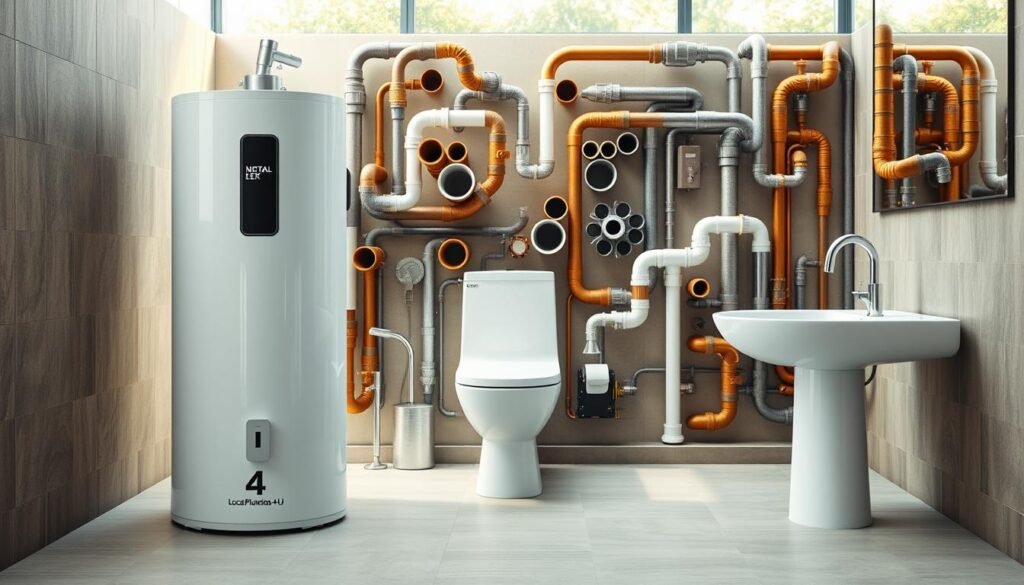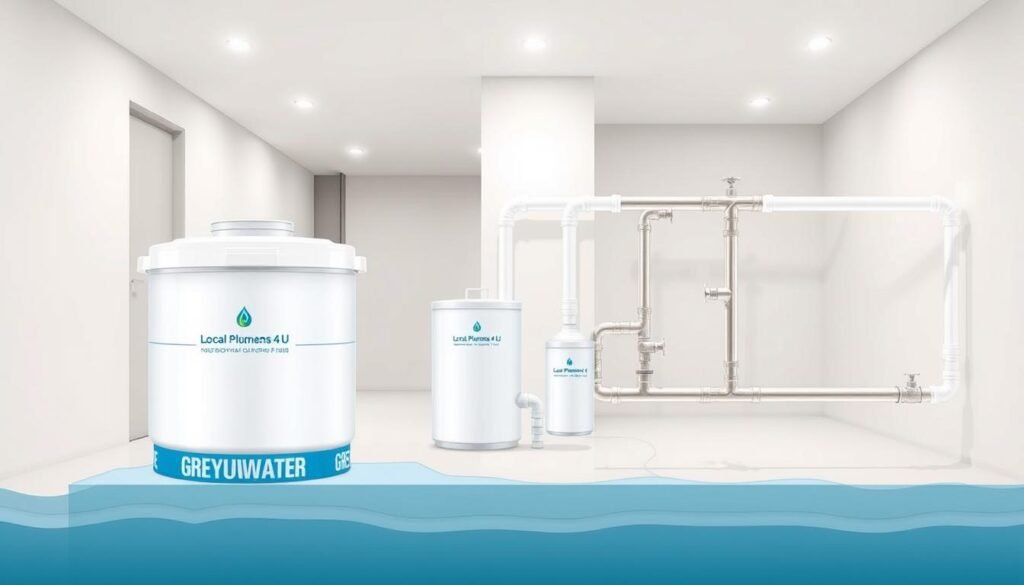Did you know that the average California household wastes over 10,000 gallons of water each year? This is due to leaks and inefficient fixtures. In the Inland Empire, where water is scarce, eco-friendly plumbing is now a must, not just a choice.
Water scarcity in Southern California has changed how homeowners think about their homes’ plumbing. Modern sustainable home plumbing is more than just fixing leaks. It’s about saving resources.
In Riverside County, San Bernardino, and Corona, green plumbing solutions are a win-win. They cut down on utility bills and help the environment. These systems use new tech and eco-friendly materials to save water and energy.
The Inland Empire’s climate makes water-efficient systems a smart choice. They help your property use resources better while keeping it comfortable and efficient.
Key Takeaways
- Efficient plumbing systems can save thousands of gallons of water annually per household
- Sustainable plumbing reduces both environmental impact and monthly utility costs
- Water conservation is key for Inland Empire residents facing regional scarcity
- Green plumbing uses eco-friendly materials and new water-saving tech
- Proper plumbing design is vital for a home’s sustainability
- Local climate conditions in Southern California make water-efficient systems economically beneficial
Understanding Sustainable Home Plumbing
Sustainable plumbing systems help Inland Empire residents save water and make their homes more efficient. As water becomes scarcer in Southern California, it’s key to know how your plumbing affects the environment and your wallet. Let’s see how sustainable plumbing can make your home eco-friendly.
What is Sustainable Plumbing?
Sustainable plumbing uses less water, less energy, and eco-friendly materials. It’s different from regular plumbing, which often wastes resources. Sustainable plumbing is efficient without losing comfort or performance.
At its heart, sustainable plumbing aims to lessen a building’s environmental impact. It considers the whole life of your plumbing system. This includes the materials in pipes and fixtures, and the energy for heating and distributing water.

In the Inland Empire, sustainable plumbing is very important because of droughts. Using water-saving tech and practices helps your community and saves you money. You can help with water conservation efforts while enjoying benefits.
Benefits of Sustainable Plumbing Solutions
Sustainable plumbing offers many benefits, including saving money. It’s a smart choice for any homeowner.
First, it cuts down on water bills. The average US household spends about $876 a year on water. In Southern California, where water costs keep going up, these savings are huge.
It also lowers energy bills. American homes spend over $1,740 a year on electricity, with about $313 going to water heating. Using energy-efficient water heaters and insulated pipes can cut this cost a lot.
Plus, your home’s value goes up. Homes with green features sell for more because buyers see the long-term value. So, sustainable plumbing is a smart investment.
Most importantly, it’s better for the planet. It saves water and energy, helping future generations and cutting down on greenhouse gases.
Key Components of a Sustainable Plumbing System
Building a sustainable plumbing system needs focus on key parts. Local Plumbers 4 U is great at designing these solutions.
Water-efficient fixtures are the base. Low-flow toilets, aerated faucets, and efficient showerheads use 20-60% less water. They work well but use less.
Choosing the right materials and insulation is also key. Eco-friendly pipes like PEX or copper are durable and green. Insulating hot water pipes saves energy and gets you hot water faster.
Water recycling systems are another important part. They use greywater from sinks and showers for irrigation or flushing toilets. This can cut water use by up to 30%.
Smart water management tech is also vital. It lets you monitor and control water use. This includes leak detection, programmable water heaters, and irrigation controllers. They save water and prevent waste.
Together, these parts make a sustainable plumbing system that saves resources and money. Local Plumbers 4 U has lots of experience with these solutions in Corona, Riverside County, and San Bernardino.
Water costs the average household over $1,000 a year. Sustainable plumbing can cut these costs a lot. Working with experts who know the Inland Empire’s water issues can help you create a system that’s good for you and the planet.
Implementing Sustainable Plumbing Practices
Starting a greener home journey is easy with sustainable plumbing practices. These practices save resources and cut down on waste. For those in the Inland Empire, these steps save money and help the environment. Let’s see how to make your plumbing system eco-friendly.
Water-Efficient Fixtures and Appliances
Switching to water-efficient fixtures is a simple way to use less water. Modern low-flow fixtures work great while using less water.
Today’s toilets use only 1.6 gallons per flush, down from 7 gallons before. This can save thousands of gallons a year for a family. Many in the Inland Empire find WaterSense-labeled toilets effective and water-saving.
| Fixture Type | Conventional Usage | Low-Flow Usage | Annual Savings (4-person household) |
|---|---|---|---|
| Toilet | 3.5-7 gallons/flush | 1.28-1.6 gallons/flush | 16,500 gallons |
| Showerhead | 5-8 gallons/minute | ≤2 gallons/minute | 2,700 gallons |
| Faucet | 2.2 gallons/minute | ≤1.5 gallons/minute | 700 gallons |
WaterSense faucets use 30% less water, down to 1.5 gallons per minute. Efficient showerheads use no more than 2 gallons per minute, yet feel satisfying.
Businesses in Corona, Riverside, and San Bernardino can save a lot by installing these fixtures. They’ve seen water bills drop by 15-30%.
Recycling and Reusing Water
Using systems to capture and reuse water is another great step. Greywater recycling systems collect water from sinks, showers, and washing machines for non-drinking uses.

A well-designed greywater system can use this water for irrigation or toilet flushing. This can cut outdoor water use by up to 50% in the Inland Empire. The system includes:
- Collection pipes from suitable fixtures
- Filtration components to remove particles
- Storage tanks with proper treatment
- Distribution systems for end uses
Rainwater harvesting is another way to save water. It collects rainwater from rooftops for various uses. A basic setup includes gutters, downspouts, a first-flush diverter, storage tanks, and a distribution system.
For a 2,000-square-foot roof in the Inland Empire, you can collect 12,000 gallons of water a year. This eco-friendly plumbing solution is very useful during droughts.
Insulating Pipes for Energy Efficiency
Insulating pipes is a key part of sustainable plumbing. In the Inland Empire, insulation helps with temperature changes.
Insulating hot water pipes saves energy and speeds up hot water delivery. Insulating cold water pipes prevents condensation and freezing.
Good insulation materials include:
- Foam pipe sleeves (easy DIY)
- Fiberglass pipe wrap (best R-value)
- Rubber pipe insulation (great for preventing condensation)
Leak detection technology also helps prevent water waste. Modern systems can find small leaks early. Some advanced options include:
Smart water monitors that attach to your main water line and alert you to unusual flow. They can detect leaks as small as a dripping faucet and shut off water if needed. For businesses, these monitors can prevent expensive water damage and waste.
Acoustic leak detection tools help find hidden leaks without damaging walls or pipes. This is very useful in older Inland Empire communities.
When starting these sustainable practices, check local rules. Many places in Riverside and San Bernardino offer rebates for water-saving fixtures and systems. Professional installation ensures your systems work well for years.
Local Plumbers 4 U: Your Partner in Sustainable Plumbing
Switching to sustainable plumbing is easier than you think. Local Plumbers 4 U can help you upgrade your home’s water systems. This will cut down on your environmental impact and lower your utility bills.
Our Commitment to Sustainable Practices
At Local Plumbers 4 U, we focus on eco-friendly plumbing for Southern California. We install water-efficient fixtures and eco-friendly piping. These choices save resources without losing performance.
We also suggest drought-resistant landscaping. This helps your plumbing system work better together. It’s a full plan to save water on your property.
How to Contact Us for Service: 909-378-9322
Want to start using sustainable plumbing? Call us at 909-378-9322 for a consultation. Our team will check your system and suggest upgrades that fit your budget and goals.
Visit our website at localplumbersincorona.com for more info. We serve the Inland Empire with our services.
FAQ: Common Questions About Sustainable Home Plumbing
How much does upgrading to sustainable fixtures cost?
The cost depends on your home’s size and needs. But, many upgrades save money on utilities in 1-3 years.
Will sustainable plumbing work with my existing system?
Yes! Most upgrades fit with your current plumbing without big changes.
Are there local rebates for water conservation?
Yes, many Southern California cities offer rebates for water-saving upgrades. We’ll find out what’s available for you during your consultation.
